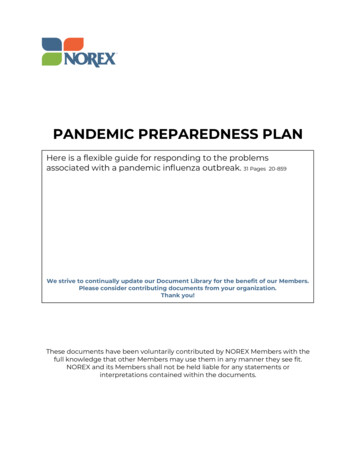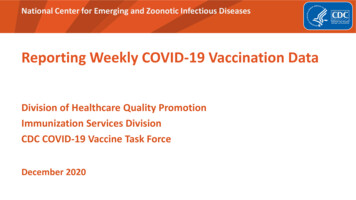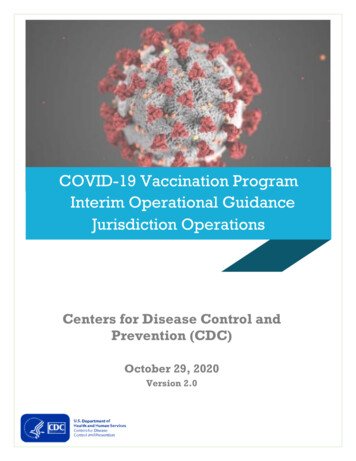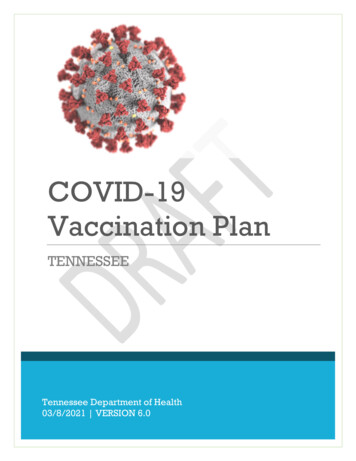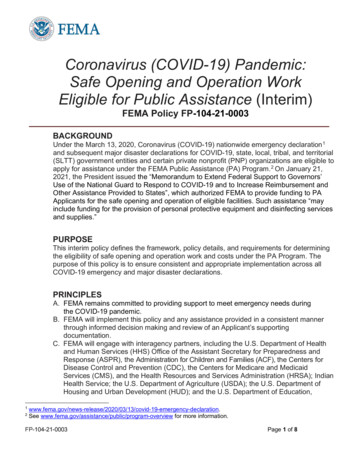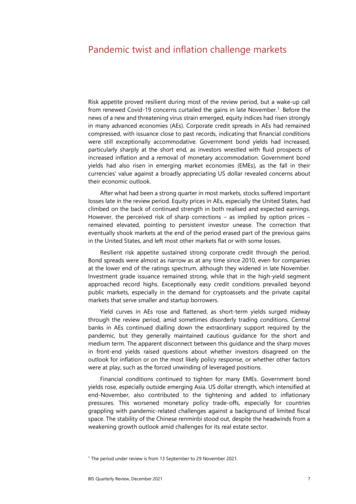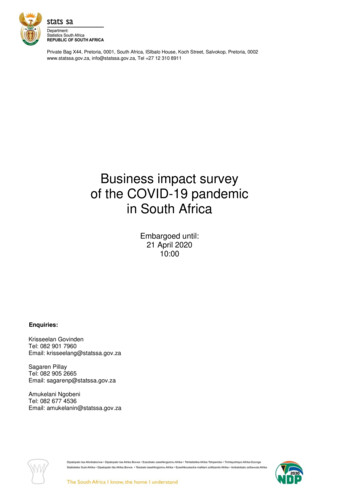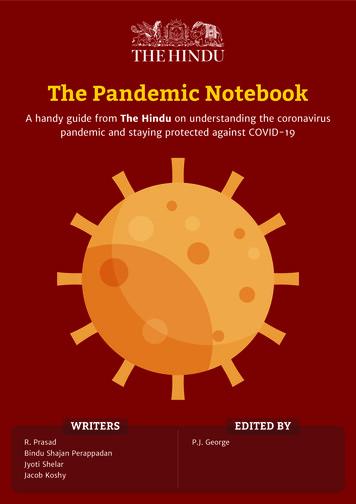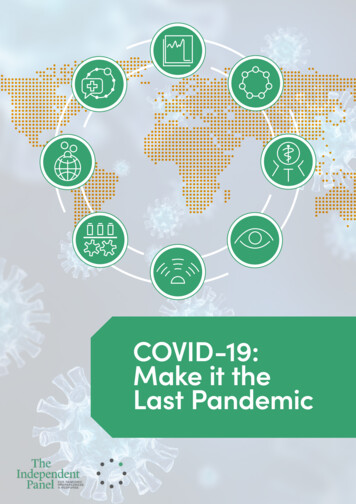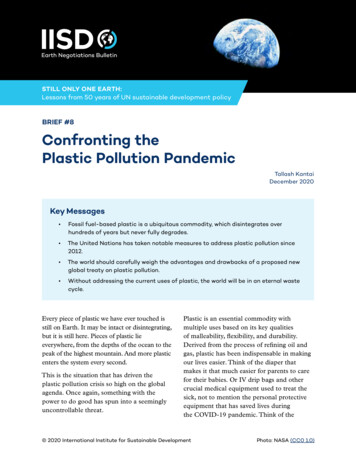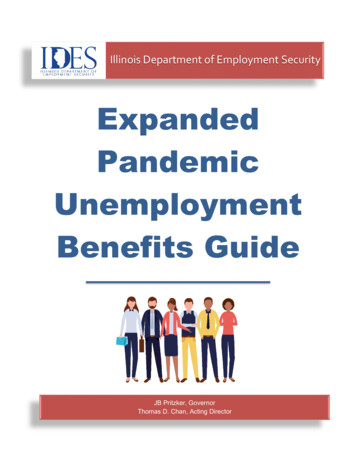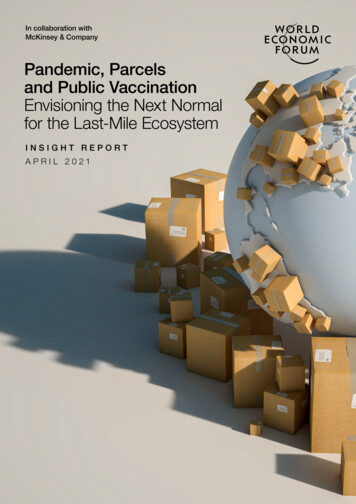
Transcription
In collaboration withMcKinsey & CompanyPandemic, Parcelsand Public VaccinationEnvisioning the Next Normalfor the Last-Mile EcosystemINSIGHT REPORTAPRIL 2021
Cover: Franck Boston, Getty Images – Inside: Getty Images, UnsplashContents3Foreword4Executive Summary5Introduction81 Six Structural Changes Are Reshaping Last-Mile Ecosystems132 What’s Next for Last-Mile Delivery?153 The Race to Patient: Challenges and Solutions for Urban Last-Mile Vaccine Deliveries20Conclusion21Contributors22Endnotes 2021 World Economic Forum. All rightsreserved. No part of this publication maybe reproduced or transmitted in any formor by any means, including photocopyingand recording, or by any informationstorage and retrieval system.Confidential and proprietary. Any use ofthis material without specific permission ofMcKinsey & Company is strictly prohibited.Envisioning the Next Normal for the Last-Mile Ecosystem2
April 2021Pandemic, Parcels andPublic VaccinationEnvisioning the NextNormal for the Last-MileEcosystemForewordGrowing demand for e-commerce deliverywill result in 36% more delivery vehicles ininner cities by 2030.Christoph WolffHead of Shaping theFuture of Mobility,World Economic ForumOrder something online one day and you’llhave it at your doorstep in no time. With socialdistancing as the new normal, consumers’ relianceon e-commerce has permanently increased.However, this age of convenience began before theCOVID-19 pandemic.Growing demand for e-commerce delivery willresult in 36% more delivery vehicles in inner citiesby 2030, leading to a rise in both emissions andtraffic congestion without effective intervention.And without effective intervention, the urban lastmile delivery emissions and traffic congestion areBernd HeidSenior Partner,McKinsey & Companyon track to increase by more than 30% in the top100 cities globally.Given the increase in urban deliveries and risingexpectations on shorter delivery times, how cancities reduce the increase in carbon emissions andcommute times by 2030? Recovering from thepandemic can be a catalyst for digitalization anddecarbonization.There has never been a time for greater global andlocal collaboration to build back better from theeffects of the pandemic.Envisioning the Next Normal for the Last-Mile Ecosystem3
Executive SummaryThe ongoing pandemic has spurred a radicalchange in the entire supply chain, especially forcingcompanies to rethink the strategies behind theirlast-mile deliveries. Companies are searching forways to provide fast and timely deliveries (fasterthan ever before) while minimizing the contactbetween humans, both on the back end indistribution centres as well as between deliverypeople and consumers. Cities have had to redirecttheir funding towards health and safety protocolswhile maintaining their focus on congestion andcarbon emissions. As such, consumers havebecome much more reliant on e-commerce-led,last-mile deliveries.The development and clinical release of variousvaccines was the remarkable success story of2020. The last-mile distribution of these vaccinesto a critical mass of people will be the unparalleledchallenge of 2021.As we begin to see the start of the end of the healthcrisis, we ask ourselves how persistent urbanchallenges like air pollution and congestion will beaddressed in a post-pandemic world? One lynchpinfor overcoming the pandemic is implementingthe mass immunization with COVID-19 vaccines.What are the logistical challenges that need to beaddressed vis-à-vis regulations and healthcareproviders? What will the “next normal” look like?The objective of the Future of Last-Mile Ecosystemproject, a collaboration between the WorldEconomic Forum and McKinsey & Co, is to provideadvanced analytics-based congestion simulationand quantitative modelling to inform last-mileecosystem players’ strategy discussions. Througha solid database, the project is designed to fosterand encourage public-private partnerships that canaccelerate the development and implementationof effective interventions that enhance last-mileecosystem’s sustainability and resiliency.This report follows an initial publication in 2020,which was launched at the World Economic ForumAnnual Meeting in Davos before the pandemicstruck. Since then, the working group of more than30 leaders and experts in the private and publicsectors have continued the discussion in the formof formal meetings, virtual roundtables and informalindustry discussions.Based on the new perspectives gathered, expertinterviews and updated data, we adjusted overallbaselines for interventions developed in 2020,such as e-commerce volumes and electric vehicle(EV) penetration rates in the automotive market.Addressing pandemic impact on last-mile delivery,we further conducted interviews with nonlogistics partners such as healthcare providers,governments, start-ups and technology pioneersto give an ecosystem view of the challenges aheadand solutions that can be implemented.In the first chapter, authors describe selectedinterventions by companies and cities that areramping up sustainability and resiliency of last-miledeliveries and its impact on cities. Then, in the nextchapter, six structural changes which occurred overthe last few months are presented:1. The pandemic has caused an increasein last-mile deliveries that will persistbeyond the pandemic2. Consumers increasingly buy newtypes of products online and considerenvironmental and health impact whenbuying3. Decarbonization of last-mile deliverieshas accelerated4. Faced with budget challenges andincreased transportation needs, citiessteer last-mile transitions5. Proven technologies are fuelling the lastmile ecosystem revolution6. New business models emerge to meetan increased demand for sustainabledelivery vehiclesIn the next chapter, the authors offer a perspectiveon how the last-mile ecosystem will evolve. Forexample, we can expect EV penetration to increasedramatically. Autonomous driving will occur in thegoods segment before it scales up into the peopletransport segment. Real-time data, re-routing andcapacity sharing will ease congestion. Deliveryoptions for consumers will diversify as commuterhabits have changed. Urban commercial traffic rulesmay become stricter to manage congestion.The last chapter is a deep-dive analysis of logisticschallenges related to vaccine deliveries. We offer initialthoughts on both challenges and solutions, inviting allecosystem stakeholders to join the discussion.In conclusion, there has never been a time ofgreater change for the “last mile”. Technologysolutions shared between governments, logisticsproviders and healthcare providers are needed toreach the end of this pandemic and move towardsthe “next normal” of the last mile.Envisioning the Next Normal for the Last-Mile Ecosystem4
IntroductionEnvisioning the Next Normal for the Last-Mile Ecosystem5
2020 has accelerated the last-mile revolutionConsumers, international companies, localbusinesses, and governments are fuellingunprecedented desire for faster and more reliableparcel shipping, at lower cost and with real-timetracking, less face-to-face interaction, less trafficcongestion and fewer greenhouse gas emissions.Accelerated by the COVID-19 pandemic, thishunger for last-mile delivery innovation is likely tochange the face of cities worldwide.We expectthat last-mileecosystems willvary significantly –country by countryand city by city.The necessary technologies are ready. Electricvehicles, real-time route optimization, parcel lockersand smart inventory management are alreadyin commercial use, while droids, autonomousnavigation and many more innovations are in testsaround the world and counting:–Amazon has already ordered 100,000 electricdelivery vans from start-up Rivian to bedelivered by 2030, and says it expects to have10,000 vans on the road making deliveries “asearly as 2021”.1 UPS announced a minoritystake in UK-based player Arrival, committing toorder 10,000 purpose-built delivery vehicles.2Daimler, General Motors and Ford are closebehind with their own models.3 New eTruckplayers like Sweden’s Volta Trucks are tailoringtheir product and solution offering to thegrowing urban delivery segment.4–The Ola Mobility Institute has opened upits technology platform to governments tofight COVID-19 through “Ola CONNECTS”(COmprehensive Navigation, NEtworking,Control and Tracking Solution). This is a platformthat allows government agencies to manageReal-Time War Rooms for various operations–Tokyo is piloting an advanced droneprogramme. FedEx is partnering with Walmart,Pizza Hut, AutoZone and other retailers totest its autonomous “SameDay Bot”, whichreportedly can navigate unpaved surfaces,kerbs and steps.5–In India, where a large section of the populationhad not adapted to e-buying, the postCOVID-19 period witnessed a rise in first-timee-commerce users. So overwhelming were theinitial months of the 2020 lockdown that leadinge commerce platforms such as Big Basket,Amazon and Grofers had to prioritize ordersand request customers to bear with delays. InIndia, logistics providers are harnessing existingdelivery systems enhanced with internet ofthings (IoT) and autonomous technologies toprovide hyperlocal delivery services, provided bysmall business enterprises, to millions of onlineshoppers.6 Restaurant aggregators looking toboost revenues have expanded into adjacentverticals such as groceries, pharmaceuticals,and alcohol. Innovation-focused start-upslike Pickup are increasingly filling a void byharnessing technological innovation to createalgorithms and systems that optimize the useof resources while ensuring a high degree ofcustomer satisfaction.at scale amid the ongoing COVID crisis, with100% data privacy and world-class security.In the state of Punjab, for instance, this freeplatform is used to provide e-passes to farmersto enable farm-to-market movement of freshproduce during the crisis.7Envisioning the Next Normal for the Last-Mile Ecosystem6
–Over the past few years, digital technologieshave transformed restaurant delivery, andrecent efforts by global tech giants in thisspace have forced new competition with localplayers. Zomato and Swiggy, both fast-growinghyperlocal food discovery and delivery startups, tied up with big grocery brands andgave customers the option to order groceriesthrough an app. The Ola Mobility Institute hasidentified reskilling and reattribution of workersto unlock new earning opportunities as a themein its report, Leveraging and protecting the gigeconomy against Covid-19: Measures by gigeconomy and governments around the world.–LeasePlan is working with several global onlineretailers to identify which of their delivery routesare most suited to make an immediate transitionto electric delivery vehicles.–The city of Santa Monica, together with LosAngeles Cleantech Incubator, recently launchedthe first zero-emission delivery zone.8 Kerbmanagement company Coord is working withcities like Nashville, Aspen, West Palm Beachand Omaha on installing smart loading zoneswhich drivers can reserve via an app and whoseprices can be adjusted dynamically, dependingon demand.9 Arguably, this pilot series is alsoa sign that the last-mile revolution has alsoreached tier-2 cities.The last-mile revolution will be fuelled by a sharedglobal desire to recover better than we werebefore the pandemic. We expect that last-mileecosystems will vary significantly – country bycountry and city by city.Last-mile has always been critical, but the issue iseven more pressing as demand has risen. Growinge-commerce demand could lead to 36% moredelivery vehicles in inner cities by 2030 leading to risingemissions and a 21% increase in last-mile deliveryinduced congestion (or 11 minutes of commute timedaily)10.” Angela Hultberg, Head of Sustainability, IKEARetail (Ingka Group), said that even in countries thathad strict lockdowns, “We witnessed a record year fordeliveries despite restrictions.”Even the largest stakeholders, such as logisticsand e-commerce players, cannot create completeecosystems on their own – nor should they. Inan “evolutionary revolution”, small businesses,from restaurants and pharmacies to florists andboutiques, will need access to last-mile servicesto keep serving customers and employingworkers in the “next normal”. Even with thevaccine distribution under way, city governmentsand healthcare providers will need to connectvaccination demand and supply to reach millions ofpeople at healthcare centres.Ecosystems should also serve public interests. Citygovernments will need to enable and support thenew ecosystems to reduce traffic congestion, noiseand air pollution. In New York City,11 for example,more than 1.5 million packages were delivered everyday before the pandemic. To meet this need, deliverycompanies racked up more than half a millionparking violations rather than work around the city’sexisting delivery ecosystem.12 Commercial deliveryentities incurred more than 123 million in parkingfines to ensure they could meet consumer needs.13In this report, we outline structural changesimpacting last-mile deliveries and put the spotlighton innovations and strategies to help createefficient, resilient and environmentally friendly supplychains that enable a thriving modern ecosystem forconsumers’ delivery needs.Envisioning the Next Normal for the Last-Mile Ecosystem7
1Six Structural ChangesAre Reshaping LastMile EcosystemsEnvisioning the Next Normal for the Last-Mile Ecosystem8
The World Economic Forum and McKinsey &Company launched The Future of the Last-MileEcosystem initiative to provide insight into theeconomic, social and environmental impacts ofe-commerce growth on last-mile logistics. Morethan 50 cross-sector leaders from cities andbusinesses meet regularly to discuss trends,interventions, and ecosystem pilots. In theirdiscussions, workshops and roundtables sincethe beginning of the pandemic, these leaders haveidentified six structural changes that are reshapinglast-mile ecosystems.1. COVI
Last-mile has always been critical, but the issue is even more pressing as demand has risen. Growing e-commerce demand could lead to 36% more delivery vehicles in inner cities by 2030 leading to rising emissions and a 21% increase in last-mile delivery-induced congestion (or 11 minutes of commute time daily)10.” Angela Hultberg, Head of Sustainability, IKEA Retail (Ingka Group), said that .
